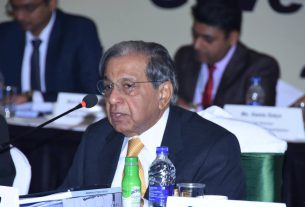We are celebrating the 52nd Year of World Environment Day, today. This year’s theme for World Environment Day emphasizes the urgency of collective action to combat the challenges of land restoration, desertification and drought resilience under the slogan “Our land. Our future. We are Generation Restoration.”
This is one of the most powerful slogans given so far while celebrating World Environmental Day.
The last part of this slogan “We are #GenerationRestoration” seems for the first time evoking a sense of responsibility among every single generation of people living today on this planet. It is now time for action, collective action forgetting the so called generation-divide of X, Y, Z, etc.
The triple planetary crisis – climate change, pollution and biodiversity loss are all inter-linked with land degradation, desertification and drought. The crisis goes beyond and the impact is much more than this triple planetary crisis whereby the world is facing multiple interlinked environmental, economic, social and health challenges.
The complexity and difficulty of addressing this global crisis calls for a collective roadmap and action.
Climate change has also been severely impacting and widening the gap between rich and poor, unemployment and lack of livelihood opportunities particularly for women in rural areas.
The need of the hour is to create green pathways combining economics with ecology to create employment and livelihood opportunities through green skills, and regenerative locally available green resources.
While the unemployment challenges are looming large with rising population, migration and shifting of people from their traditional occupation, the need of hour is to create green economies as much as possible. In such a situation, green skills, renewable energy, and regenerative resources should be given priority in meeting both the economic and ecological needs.
As the global ecological consciousness dominates over economics for the first time, it brings in enormous opportunities for eco-friendly products both in the domestic and international market. With systematic planning, investment and facilitation there is an opportunity to create millions of green employment opportunities in both rural and urban areas by producing different marketable utility and hedonic products.
Let us take the example of eco-friendly jewellery. Due to rising awareness and environmental consciousness the demand for eco-friendly jewellery, accessories and décor products are rising fast. A supply-demand gap is clearly visible. People and entrepreneurs who have understood the phenomenon have been doing well and extracting premiums from these environment-conscious consumers.
As the market is evolving so as the producers are trying their best to woo the consumers using different permutations and combinations. Despite the fact that the products sold in the name of eco-friendly or green are either deceptive or it is a sheer greenwashing. Environmentally sensitive consumers often encounter misleading sustainability claims by brands and retailers selling jewellery and accessories in the name of sustainability. Genuine products made up of eco-friendly materials with supply chain transparency and certification can rule the market.
My personal experience of working on different eco-friendly and bio-degradable materials like bamboo, clay, golden grass, waste wood, waste fabric (particularly Odisha handloom fabric), seeds, beads made up of wood, palm leaf, etc in manufacturing eco-friendly jewellery line has created a craze among consumers.
To enhance the effect and aesthetic value of the jewellery I used different local art-forms like Pattachitra and Tribal art, that too, using natural colours. The production process is environment friendly to a significant extent as we use hand tools, use no chemicals, and consume no water, and making biodegradable products. This small initiative is a testimony to the making of competitive, aesthetically appealing marketable products acceptable by different niche segments of customers.
The innovations in solid bamboo for making bangles, necklaces, earrings, tiaras, etc and products made using other different types of eco-friendly materials like bamboo, waste-wood, clay, golden grass, natural seeds, handloom fabric, etc have got wide acceptance in the market.
In the pursuit of creating employment and livelihood opportunities we can focus on creating resources like plantation of bamboo, golden grass, different natural dye-yielding plants, seed plants, medicinal plants that can help restore the local ecosystem and fight back desertification and land degradation.
Most of these plants are climate resilient and do not need any chemical fertilizer, pesticide or even much water to grow. A planned investment in these regenerative resources can protect the environment and help fight climate change while creating significant opportunities for a green economy in the rural areas.
This International Environment Day, let us work together and move towards changing our lifestyle from a take-make-use-throw attitude to a more sustainable lifestyle that can have a trickledown effect on the downstream value chain in protecting our land and collective future, thus justifying “We are #GenerationRestoration.”
On the other side, the business prospects for sustainable products are rising at a super fast speed. A sizable percentage of global fashion consumers are already highly concerned about sustainability and consistently make purchasing decisions to lower their ecological footprint.
Many surveys in key markets suggest that the demand for eco-friendly jewellery and accessories is rising exponentially and creating opportunities for artisans, designers, manufacturers’ suppliers and raw material producers. The demand for eco-friendly jewellery could further rise in the coming years as more shoppers gravitate toward sustainable practices.
(Ms Priyadarsini Das, popularly known as the “Green Queen of Odisha” is a trendsetter for Eco-friendly Jewellery line in the name of “Ecodarsini”)



